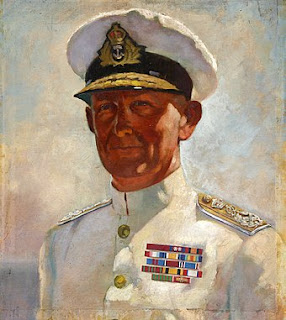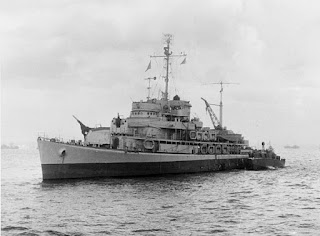Underway
By: Admiral H. Kent Hewitt
By: Admiral H. Kent Hewitt
 |
| Admiral H. Kent Hewitt c. 1945 |
By 1630, when Gozo had been sighted from the Monrovia, the wind was blowing from the west with a force of about 6/7 . . . It would make the coast on which we were to land, which had a NW-SE trend, a lee shore. We could not, of course, anticipate the sort of surf we might have encountered on the Moroccan coast in TORCH, but the chop might cause considerable difficulty. Subsequently, it was learned that General Eisenhower and Admiral Cunningham, on Malta, were so concerned with the weather as to have been on the point of postponing the operation.
 |
| Eisenhower as General of the Army, 1945 |
Luckily, they held on. At the time, my principal worry was that the landing craft might be so slowed as to delay unduly their arrival at their destination. This was a contingency which was effectively taken care of by Admiral Conolly, who dashed about in the Biscayne, shepherding his convoys, and having them cut corners, with the result that they were exactly on time in spite of the adverse conditions. When I observed the rolling of some of the British LCI(L)s, as they rounded Gozo, I could not but wonder how effective some of the troops were at first going to be. But perhaps they were all the more willing to get ashore. The Eastern Task Force, fortunately, would have a lee for its landing.
 |
| Portrait of commissioned by the Ministry of Information of Admiral Andrew Cunningham, 1st Viscount Cunningham of Hyndhope about 1943 |
My mind was greatly relieved by the prediction of my efficient aerographer, Lieutenant Commander R. C. Steere (whose forecast of surf conditions off Morocco in TORCH had been so accurate), that the wind would probably subside greatly by 2200. This prediction again proved to be correct. As darkness fell, the shipping around Gozo made quite an inspiring sight. Ahead were our landing craft, inshore of us was British KMF-18, slightly behind schedule, and numerous British landing craft. Astern was Admiral Kirk’s second section, which was then detached to proceed to the CENT assault area. Also coming in from the westward were the cruisers of the Covering Group, proceeding to take stations with their assigned assault groups.
 |
| Rear Admiral Richard L. Conolly, pictured here on the right, alongside British Major General J. L. I. Hawkesworth aboard USS Biscayne, 6 September 1943. |
. . . Much had already been accomplished by the strategic bombing command in attacking enemy airfields and in softening the beach defenses. To avoid premature disclosure of the point of attack, and consequent concentration of the defense, it had been necessary to follow initially a very general bombing program, with only casual attention to vital objectives, until the last day or so prior to the landing. This was a situation quite different from small island attacks in the Pacific where, with the enemy cut off by sea, the defenses could be bombed and shelled for days on end prior to an actual landing.
 |
| Biscayne as an amphibious force flagship off Anzio on 21 January 1944 or 22 January 1944 during Operation Shingle. A PT boat is alongside her. |
As we neared the coast, evidence of our air attacks was clearly visible in the A. A. fire, the flares, and the conflagrations noted at various points along the beach. The British beacon submarines were picked up on schedule, the transports arrived in their areas, and the work of getting out boats and disembarking the troops was commenced. Some of our own vessels were illuminated and silhouetted to us by searchlights played from the beach, but they did not seem to have been sighted by the enemy . . .
No comments:
Post a Comment